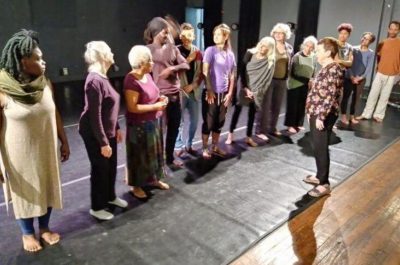
Credit: Denaise Seals
The Transformative Joy of Dance at Any Age
By Rebecca Theim for Next Avenue
Part of the Vitality Arts Special Report
Lifelong dancer and choreographer Nancy Havlik wants the world to know that regardless of age, physical condition or experience, “people transform through the joy that dance offers them. You can see them light up and become more alive.”
Havlik, 78, has 25 years of experience teaching interactive creative movement and dance workshops for older adults through Arts for the Aging (AFTA), aa nationally recognized, Rockville, Md.-based organization that brings free artistic programs to older adults in the Washington, D.C. area.
Northfield Retirement Community provides wellness resources that support the wellbeing of the whole resident – mind, body and spirit – and is dedicated to helping residents feel their best. Learn more about campus life at NRC.
Earlier this month, Havlik’s AFTA-sponsored Quicksilver, an improvisational dance company for older adults, staged “Imaginary Gardens,” in partnership with the Dance Performance Group, a small company of professional dancers and musicians of which Havlik is artistic director and choreographer. The interactive, interpretative dance production featured dancer Shanna Lim, who got most of the audience involved in the performance.
“We had all ranges of people,” said Lim, 41. “I didn’t know who the audience would be. I opened before it started, and basically warmed up the audience. I coaxed as many as I could down to the stage, and then more came as we started the show.”
Lim, whose work spans hip-hop, and installation and body art, is one of the more unconventional dancers Quicksilver participants have encountered.
“I came out in full body paint, that real-interesting-piece-of-art-weirdo, and everyone was completely cool,” she recalled. “I got huge satisfaction —not a huge surprise, but more like ‘cool!’ — seeing that generation, and having them all behind me, and seeing them learning. I turned around and I felt accepted.”
Quicksilver and other AFTA programs (which include drawing, painting, poetry and music) engage 1,000 older residents in more than 800 programs annually held at 33 community and residential care centers in the Washington, D.C.-area, in partnership with area museums and cultural institutions. The goal is to engage older adults and their caregivers through regular participation in arts activities that improve physical fitness and cognition, and combat isolation.
“Quicksilver is unique among the programs we offer because dance is accessible to everyone,” said AFTA program director Brandi Rose. “It’s something everyone can tap into, no matter what their cognitive level or physical ability. It’s such a great combination that we’ve thought about how we can bring it into other art disciplines.”
Science Backs the Benefits of Dancing
In addition to the joy Havlik and Lim say dancing brings to participants young and old, there’s science supporting the benefits it offers older adults. Numerous U.S. and Europeans studies have shown that regular dance improves balance and enhances cardiovascular health, stems or slows the advancement of dementia and boosts emotional health.
Patients with Parkinson’s Disease who took part in regular tango lessons experienced improved motor skills and balance, reduced non-motor symptom severity and were able to better perform daily activities, researchers found.
A two decade study by the Albert Einstein College of Medicine found that dancing was the only physical activity that resulted in lower reported rates of dementia among older people who danced frequently. A more recent study of older women in Japan found that those who danced often had a 73 percent lower chance of becoming disabled during the study period, contrasted with women who didn’t dance. Again, no other physical activity — including walking or yoga — produced such significant results, researchers found.
Why is dancing so powerful? Researchers theorize it’s because it demands both mental and physical effort. “Dancing requires not only balance, strength, and endurance ability, but also cognitive ability: adaptability and concentration to move according to the music and partner, artistry for graceful and fluid motion, and memory for choreography,” a study by Chinese researchers concluded.
Quicksilver Participants Dance Around
Quicksilver dancers, who range in age from 65 to 88, are involved in weekly programs within the group, Rose said. Twice a month, they take their performances to the community and senior centers and residential facilities AFTA serves.
“We go out in the community and work with people, some who have never danced before,” Havlik said. “People always say they can’t dance. People get that in their heads, that ‘I’m no good at that.’ I’m really good at getting people dancing; that’s one of my strengths.”
Because of Washington, D.C.’s global draw, participants are often multicultural. Havlik and her Quicksilver co-director Anthony Hyatt, who provides music for the programs, have a trick to engage international participants.
“They may not have the same language, but you don’t need a common spoken language to dance,” Havlik said. “They respond to different music. Anthony knows almost all national anthems of the world, so when we have someone new, he’ll play their national anthem.”
Professional dancers in Havlik’s Dance Performance Group relish working with Quicksilver participants. “These younger dancers are in very competitive fields,” Havlik said. “It’s very tough to be a dancer these days; there’s no money in it. But there’s a warmth and generosity that comes with age, and my young dancers love dancing with the older dancers.”
Lim said her “Imaginary Gardens” experience, her first time working with Havlik, confirmed that observation. “I just liked being part of the energy and the presence of elders who have been there, done that, and getting the chance to work with people who have a full level of knowledge in areas I don’t,” she said.
Quicksilver members also benefit as they begin to grapple with the possibility of their own physical and cognitive limitations. Working with other older adults “allows them to confront some of the fears they may have about aging, and recognize that when those physical or cognitive declines come, there’s still life and there’s still joy,” Rose said.
